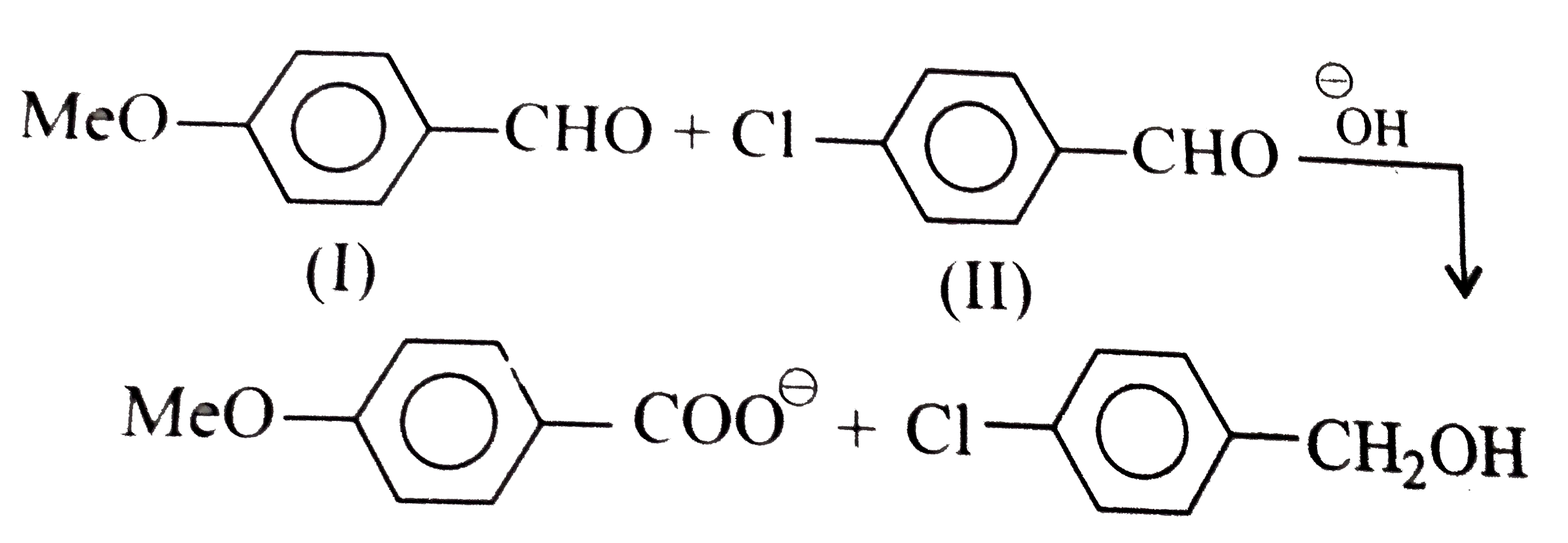Assertion (A): The following cross Cannizzaro reaction occurs.

Reason (R ): Rate of reaction is:
Rate = K[Aldehyde(I)][Aldehyde(II)][ΘOH] and bimolecular.
If both (A) and (R ) true and (R ) is the correct explanation of (A).
If both (A) and (R ) are true but (R ) is not correct explanation of (A).
If (A) is true but (R ) is false.
If (A) is false but (R ) is true.
The correct Answer is:D
Step by step video, text & image solution for Assertion (A): The following cross Cannizzaro reaction occurs. Reason (R ): Rate of reaction is: Rate = K["Aldehyde(I)"]["Aldehyde(II)"][overset(Θ)(OH)] and bimolecular. by Chemistry experts to help you in doubts & scoring excellent marks in Class 12 exams.
Topper's Solved these Questions
- BOOK - CENGAGE CHEMISTRYCHAPTER - ALIPHATIC AND AROMATIC ALDEHYDES AND KETONESEXERCISE - Archives Objective10videos
ALIPHATIC AND AROMATIC ALDEHYDES AND KETONES
- BOOK - CENGAGE CHEMISTRYCHAPTER - ALIPHATIC AND AROMATIC ALDEHYDES AND KETONESEXERCISE - Archives Multiple Correct8videos
ALIPHATIC AND AROMATIC ALDEHYDES AND KETONES
- BOOK - CENGAGE CHEMISTRYCHAPTER - ALIPHATIC AND AROMATIC ALDEHYDES AND KETONESEXERCISE - Exercises Single Correct72videos
ALIPHATIC AND AROMATIC ALDEHYDES AND KETONES
- BOOK - CENGAGE CHEMISTRYCHAPTER - ALCOHOL,PHENOL AND ETHERSEXERCISE - Archives Analytical And Descriptive15videos
ALCOHOL,PHENOL AND ETHERS
- BOOK - CENGAGE CHEMISTRYCHAPTER - AMINESEXERCISE - QUESTION BANK1videos
AMINES
Similar Questions
Knowledge Check
- Question 1 - Select One
Which of the following aldehydes will show Cannizzaro reaction ?
AHCHOBC6H5CHOC(CH3)3CCHODAll of these. - Question 2 - Select One
Which of the following aldehyde can give Cannizzaro reaction with base ?
ACH3−CH2−CH2−CHOBH3C−C=CHCH3 | CH3C(H3C)2CH−CH2−CHOD(CH3)3C−CHO. - Question 3 - Select One
Which of the following aldehyde will undergo Cannizzaro's reaction ?
AEthanalBPropanalCm-ChlorobenzaldehydeDPhenylacetaldehyde.
Cannizzaro reaction is a chemical reaction named after Stanislao Cannizzaro that involves the base-induced disproportionation of two molecules of a non-enolizable aldehyde to yield a carboxylic acid and a primary alcohol.Cannizzaro Reaction Mechanism details the method to get one molecule of alcohol and one molecule of carboxylic acid from two molecules of a given aldehyde.he reaction is executed by a nucleophilic acyl substitution on an aldehyde where the leaving group attacks another aldehyde. A tetrahedral intermediate results from the attack of hydroxide on a carbonyl. This tetrahedral intermediate collapses, thereby reforming the carbonyl and transferring a hydride which attacks another colony. Now, a proton is exchanged by acid and alkoxide ions. When a base of high concentration is introduced, the aldehyde forms an anion which has a charge of 2. From this, a hydride ion is transferred to a second molecule of the aldehyde, forming carboxylate and alkoxide ions. The alkoxide ion also obtains a proton from the solvent for the reaction.Which of the following aldehydes will undergo Cannizzaro's reaction ?
View SolutionWhich of the following aldehydes can give Cannizzaro reaction with base?
View SolutionAssertion (A) : For: aA+bB→ Product. The order of reaction is equal to (a+b).
Reason (R ): Rate of reaction =k[A]a[B]b.View SolutionWhich one of the following aldehydes does not give Cannizzaro's reaction?
View SolutionAssertion (A) : Formation of HI is a bimolecular reaction.
Reason (R ): Two molecules of reactants are involved in this reaction.View Solution

